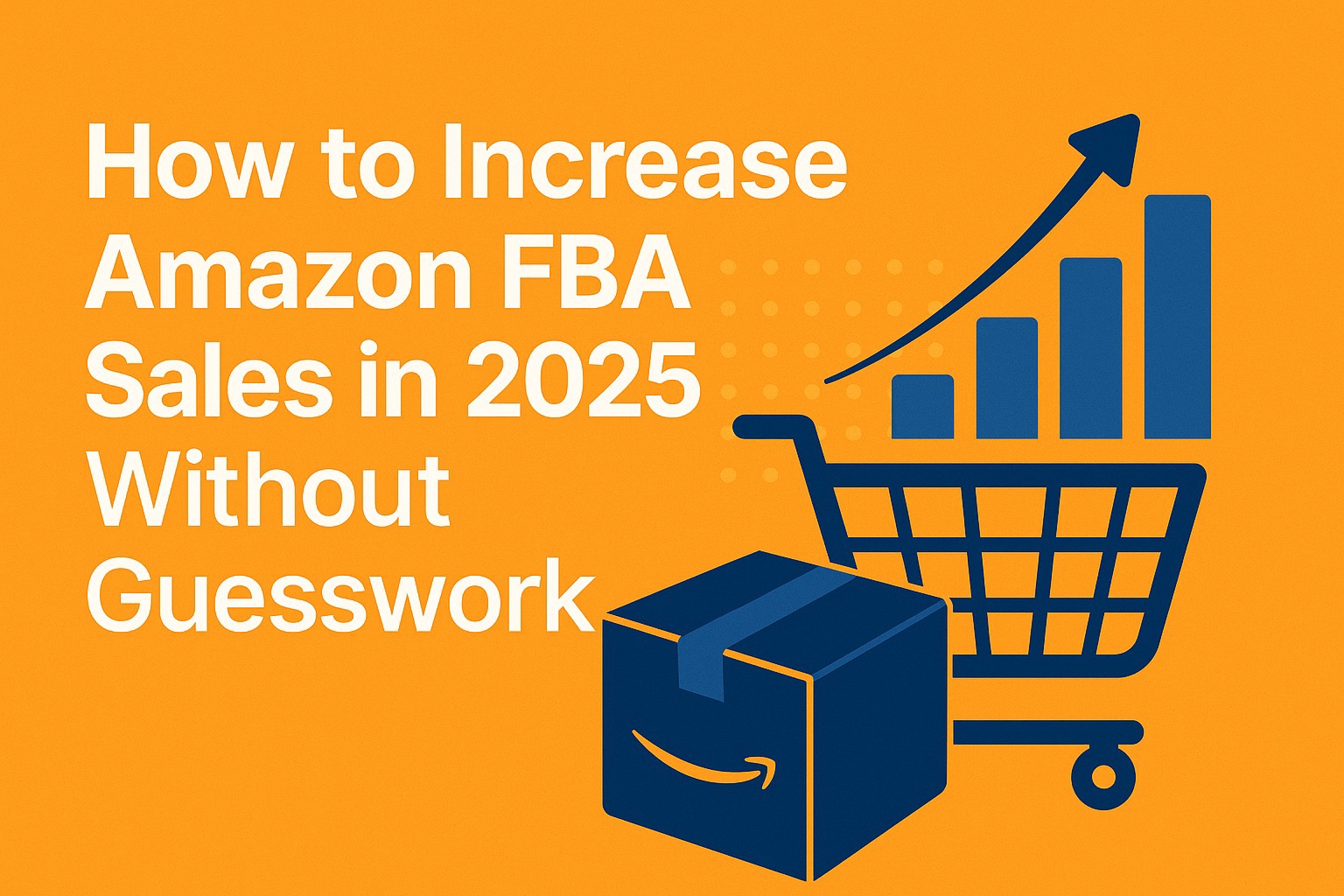How to Increase Amazon FBA Sales in 2025 Without Guesswork
Amazon FBA sellers often chase trends, gimmicks, or new tools—while ignoring the proven fundamentals that drive sales. In 2025, boosting your FBA performance depends on three things: your listing, your offer, and your execution.
This guide focuses on practical, no-fluff tactics to increase Amazon FBA sales using what already works—enhanced with 2025 data and tools.
What’s Changed in 2025 (And Why You Need a New Playbook)
Amazon has made three major shifts that impact how you grow FBA sales:
- Search behavior is more mobile and voice-driven
- Amazon’s algorithm favors conversion and relevance over keyword stuffing
- AI-powered competitors are optimizing faster than ever
If you’re still running your business like it’s 2020, you’re getting outranked, underclicked, and overpriced.
Related: Why Your Amazon CTR is Low (and How to Fix It Without More Ads)
Step 1: Fix Your Product Listing Before Anything Else
If your listing isn’t converting, no amount of traffic will help.
Run a Full Listing Audit:
- Check your main image clarity and zoomability
- Ensure your title communicates a benefit, not just features
- Scan bullets for readability, relevance, and outcomes
- Review your A+ content preview on mobile
- Check star rating and number of reviews
Use a tool like SellerMax.ai to run a listing audit and find low-CTR patterns and weak messaging.
Step 2: Understand What Makes Buyers Click in 2025
Today’s buyer behavior is shaped by:
- Thumbnail impressions (main image + title) on small screens
- Benefit-driven bullets they can skim fast
- Social proof: star ratings, reviews, and answered questions
Your listing should:
- Lead with value-first phrasing (e.g., “Pain-Free Typing – Ergonomic Keyboard”)
- Include emotional hooks in bullets (use cases, outcomes)
- Avoid jargon and keyword clutter
Your buyer needs to trust you before they scroll. That starts in search.
Related: Amazon Listing Optimization in 2025: Strategies That Actually Drive Conversions
Step 3: Optimize for Amazon’s A10 Algorithm
A10 evaluates:
- CTR and conversion rate (especially for organic rank)
- Time on page and bounce rate
- Price competitiveness
- Sales velocity and consistent fulfillment
To win in 2025:
- Stop overloading backend keywords
- Avoid gimmicky titles that harm CTR
- A/B test bullets, pricing, and images using Amazon’s tools
Don’t game the system, align with what A10 rewards.
Step 4: Improve Offer Design (Not Just Listing Copy)
Sometimes your product isn’t the problem – your offer is.
Fixable Offer Issues:
- You have no clear differentiator
- You bundle the wrong items
- You’re charging more than the perceived value
- Your packaging feels generic
What to Try:
- Add an insert card with a bonus or guide
- Test a limited-time bonus (e.g., “Free straw set inside”)
- Rethink pricing tiers: offer 2-pack and 5-pack variants
Test positioning your offer around one clear promise or problem it solves.
Step 5: Launch Micro-Campaigns, Not Just Broad PPC
Instead of scaling one big campaign, split testing smaller PPC campaigns leads to better ROI.
Campaign Breakdown:
- 1 auto campaign (broad discovery)
- 1 exact-match keyword campaign (top performers only)
- 1 product targeting campaign (for key competitors)
- 1 brand defense campaign (your ASIN and brand name)
Measure CTR, conversion rate, ACoS, and TACoS weekly—not just impressions.
Step 6: Extract Buyer Language from Reviews and Q&A
Use your own and competitor reviews to:
- Pull benefit language into your bullets
- Identify real objections to address visually
- Surface common outcomes customers care about
Tools like SellerMax analyze this at scale. If you’re writing listings without reading reviews, you’re guessing.
Step 7: Increase Product Visibility Organically
Boosting sales also requires surfacing your product more often without paying every time.
Organic visibility boosters:
- Ask and answer real customer questions
- Encourage reviews with follow-up messages (TOS compliant)
- Use Amazon Posts to tell use-case stories
- Update your product every 6–8 weeks (signals freshness)
Amazon surfaces listings that show ongoing relevance and community interaction.
Step 8: Expand Into Adjacent Keywords and Variations
Stop chasing the same high-competition keyword set.
Expand strategically:
- Use mid-tail and long-tail phrases (e.g., “durable travel backpack for moms”)
- Target seasonal or event-based search terms
- Identify underserved sub-niches
Use reverse-ASIN tools or SellerMax keyword analysis to uncover what competitors aren’t targeting.
Step 9: Use A+ Content and Brand Story Modules Intelligently
Not all A+ is created equal.
What works:
- Visual comparison tables
- Image + overlay text combinations
- FAQ-style benefits (e.g., “Is this dishwasher safe?”)
What fails:
- Stock lifestyle photos with no context
- Repetition of bullets in visual form
- Generic brand “mission” copy
Make every module answer a sales-relevant question.
Step 10: Track What Matters (and Ignore the Rest)
Sellers often obsess over irrelevant metrics.
Metrics to watch:
- Sessions: How many people visit your listing
- Unit Session Percentage: Your real conversion rate
- CTR from search: Use Brand Analytics or SellerMax
- Keyword rank movement
- Review count and star rating trend
Skip obsessing over impressions or page views if they’re not converting.
Related: Possibility to Increase Amazon Sales With Targeted Listing Optimization
CTA: Run a Listing Audit That Tells You What to Fix
Most sellers are working on the wrong problem. They add more keywords, run more ads, or reprice endlessly – without fixing the listing.
Use SellerMax.ai to:
- Analyze your CTR, conversion, and buyer sentiment
- Uncover what’s hurting your sales
- Get specific, ranked suggestions to improve listing performance
→ Run your free SellerMax audit today and stop guessing what’s wrong.
Final Takeaway: Better Listings, Better Sales
Increasing FBA sales in 2025 isn’t about working harder. It’s about:
- Saying the right thing in the right place
- Knowing how your buyer thinks
- Making sure your offer earns the click and the sale
The process is fixable. The results are compounding.
Start by fixing the listing. The rest follows.
